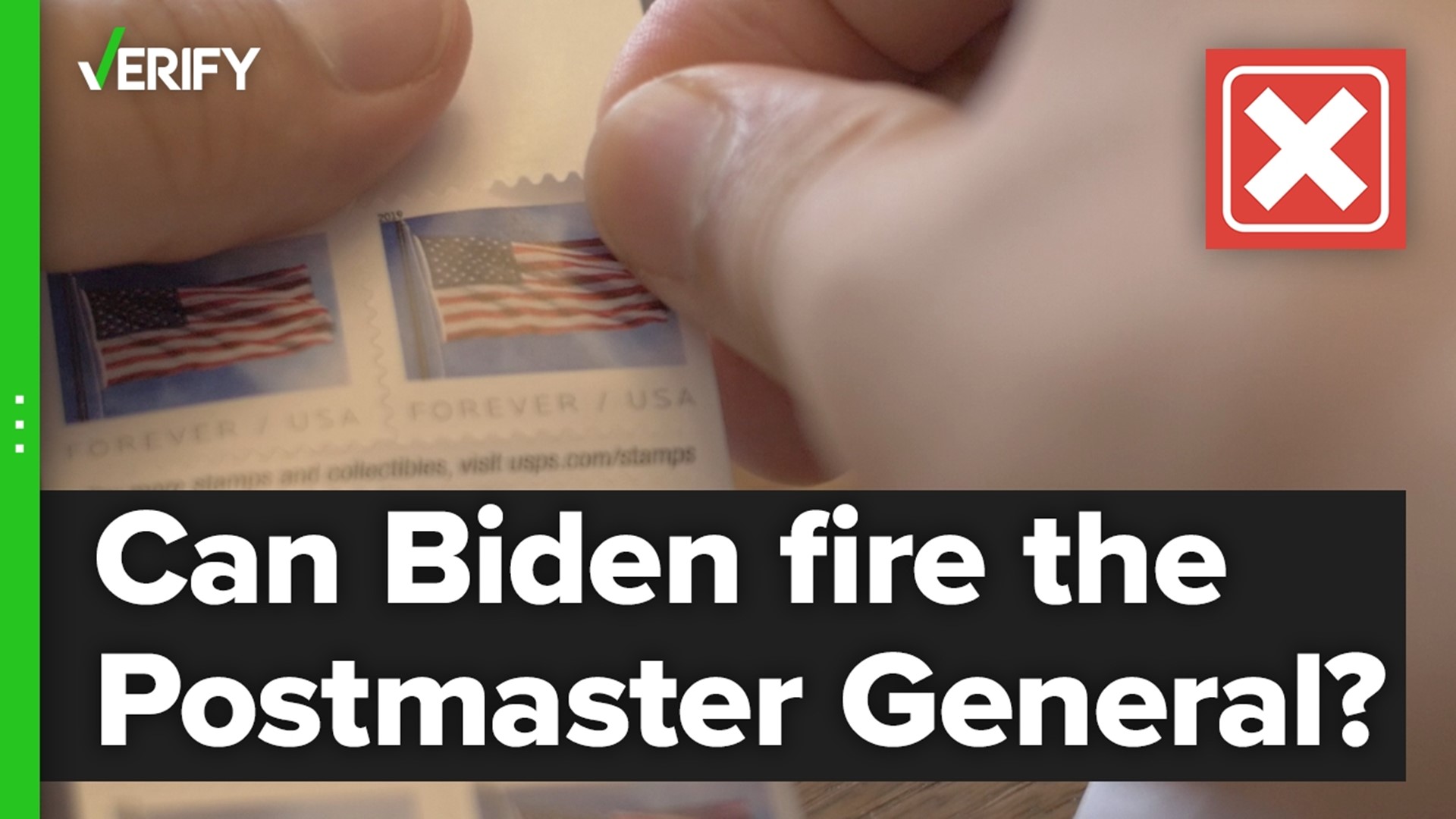The U.S. Postal Service has enacted a series of changes over the last two months, including an increase in the price of stamps, a temporary price hike for mailing packages through Christmas and slower delivery for some first-class mail and periodicals.
The changes are part of Postmaster General Louis DeJoy’s 10-year plan aimed at achieving financial stability for the Postal Service, which the U.S. Government Accountability Office says has lost $87 billion over the past 14 fiscal years.
But DeJoy’s plan has not come without criticism. The attorneys general in more than a dozen states filed a complaint earlier this month over the postmaster general’s plan.
VERIFY viewer Em emailed the team, wondering if President Joe Biden could fire DeJoy.
THE QUESTION
Can the president fire the U.S. postmaster general?
THE SOURCES
THE ANSWER
No, the president can’t fire the U.S. postmaster general. Only the Postal Service’s board of governors has the power to remove the postmaster general.
WHAT WE FOUND
The Postal Service is overseen by a board of governors, which includes nine members, as well as the postmaster general, who is essentially the CEO of the Postal Service, and the deputy postmaster general.
“The Board directs the exercise of the powers of the Postal Service, directs and controls its expenditures, reviews its practices, conducts long-range planning, approves officer compensation and sets policies on all postal matters,” the Postal Service says on its website. “The Board takes up matters such as service standards and capital investments.”
According to federal law, only the Postal Service’s board of governors can appoint or remove the postmaster general. Title 39 of the U.S. Code says, “The Governors shall appoint and shall have the power to remove the Postmaster General, who shall be a voting member of the Board.”
The president used to be able to appoint or remove the postmaster general, but that hasn’t been the case for decades.
In 1970, Congress passed the Postal Reorganization Act, which overhauled the postal system. The legislation abolished the Post Office Department, which was part of the Cabinet, and created the U.S. Postal Service that exists today – an independent agency of the executive branch.
The law also changed who was in charge of appointing the U.S. postmaster general.
Prior to the Postal Reorganization Act, the postmaster general and eight other high-ranking positions were appointed by the president and approved by the Senate. However, a 1968 president’s commission concluded that because the postmaster general was “the personal choice of the president,” the tenures of postmasters general were short and led to a lack of leadership continuity.
That instability in leadership, an outdated organizational structure and increasing financial losses put the post office at a crisis point, the commission said. The commission recommended the postal system be restructured and operate more like one of the country’s largest businesses with a board of governors instead of as a government agency. The commission’s idea came to fruition with the passage of the Postal Reorganization Act.
Under the transformative law, nine governors who “shall represent the public interest generally” were to be appointed by the president and approved by the Senate. Those governors appoint the U.S. postmaster general. The governors and postmaster general select the deputy postmaster general.
The Office of Inspector General of the U.S. Postal Service, an independent agency within the Postal Service that audits the operations of the Postal Service, said in a 2016 report that the change in oversight was made to create a “buffer between the political establishment and the U.S. Postal Service.”
No more than five governors on the board can adhere to the same political party. Originally, the governors’ terms were nine years, but legislation passed in 2006 reduced the term lengths to seven years. The governors’ terms are staggered, meaning they don’t all start and end at the same time. Governors appointed in the middle of a term serve the remainder of that term. Governors can serve a maximum of two terms.
Federal law says governors can be removed by the president but only “for cause.” So, the president can appoint governors to the Postal Service’s board and remove them “for cause,” but he can’t appoint or remove the U.S. postmaster general.
Earlier this year, President Biden nominated Anton Hajjar, the former general counsel of the American Postal Workers Union, Ron Stroman, a former deputy postmaster general, and Amber McReynolds, who leads the nonprofit National Vote at Home Institute, to the governing board. The Senate approved all three nominees in May. This means five of the board’s nine members identify as Democrats or independent. It’s up to the board to decide if DeJoy will remain postmaster general.
More from VERIFY: Yes, it's true that the FDA hasn't had a permanent leader since January

